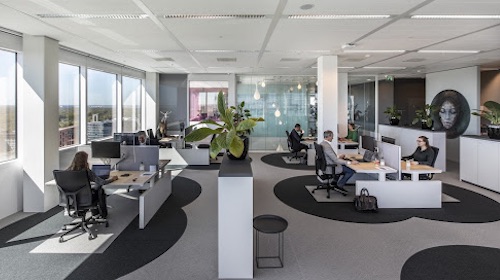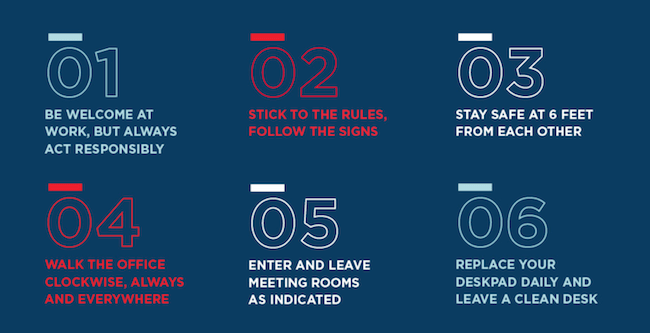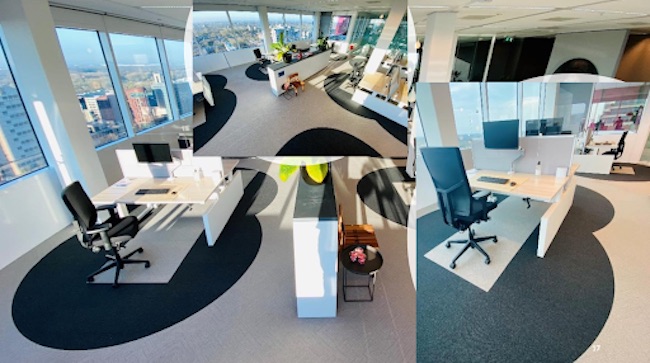Commercial real estate firm Cushman & Wakefield has developed guidelines for companies around the world planning a return to their offices, based on learnings from helping 10,000 organisations in China.
A crucial part of realising our “new normal” as a society will be the process of transitioning a global workforce back to the workplace safely. Of course, these offices will look quite different from those we all left behind in March.
Cushman & Wakefield, the global real estate development company, is fresh from helping 10,000 organisations in China move nearly one million people back to office spaces. Working in consultation with health organisations, medical advisors, and government officials, they developed guidelines for how to get people back to the workplace as restrictions lift.
The company used its own office space in Amsterdam as a pilot, calling it “The 6 Feet Office.” This layout — including the use of large circles and other visual cues on the floors (similar to hospitals) — helps ensure a separation of six feet between employees at all times. The firm has a task force working to prepare landlords and tenants for post-COVID-19 recovery and has a “Recovery Readiness” playbook on their website that offers guidelines for other companies.
Antonia Cardone is America’s lead of Total Workplace at Cushman & Wakefield, which encompasses everything from the design of workspaces to employee experiences within them. We spoke with Cardone to understand how companies are dealing with the new normal so far, and what lessons they’ve learned in Asia that might be applicable for companies now in other parts of the world.
The 6 Feet Office: Helping you Adjust to a New Normal
Understand how the needs of your employees have changed
Cardone notes that for most companies the return to the office should be a slow and gradual one. Certain groups should stay home as long as possible — those who are immuno-compromised, those in caretaker roles, and people who would be unduly exposed by complex or long commutes. According to Cardone, the people who need to come back are those who can’t be productive at home, perhaps because they live in a house shared with many others, have kids impacting their day, or don’t have the right desk or home office set up. People who need things in the office like labs, secure files, and high computing power, may also wish to return. Lastly, people who are on teams more effective with proximity should return in the first waves — perhaps those working on emergency response, innovation, or SWAT teams. Cardone feels the bottom line is people should be able to make their own decisions to return based on their individual needs.
Cushman & Wakefield provides an evidenced-based assessment tool for surveying employees to understand those needs. The survey also helps companies determine who should come back to the office first, ensuring a phased approach. Another key question it answers is how the employee is faring while working from home: are they feeling productive and engaged? Do they have the tools they need? What are their concerns about going back to the office?
How to design workplaces for the new normal
In the future, according to experts, traffic flows in office spaces will be designed to go in one direction to reduce “pinch points”— those crossover points where people may collide. Cardone notes we are likely to see deliberate direction in the floor plan to help orient people and avoid crossings and intersecting. We will also see reduced capacity of some rooms. A six-person meeting room might have chairs removed so it becomes a room for two. We might see alternate desks in use, while the others are cordoned off, like a checkerboard.
Of course, shared kitchens are being handled in completely new ways in the offices in China that are now open, with prepackaged, single item snacks available instead of shared “bins.” They are also reducing touchpoints on anything previously shared, such as copiers, printers, coffee pots, supplies, and cupboards. Figuring out how to handle the sanitization of bathrooms is perhaps one of the trickiest issues facing facilities managers, according to Cardone.
According to a recent Fast Company report, some companies are considering the use of beacons (transmitters) to track employee movement with their phones and alert them if they get too close to others. To mitigate some of the contact-based spread of COVID-19 on office surfaces, employees can use a paper placemat for their desk which can be disposed of at the end of the day. However, some may choose a different route for environmental reasons. Other companies are thinking about using clear shields between workstations, like sneeze guards or using disposable supplies to keep germs from spreading.
In Asia, Cushman & Wakefield is seeing the continued use of virtual meetings to avoid the need to go into conference rooms, even if people work together in the office. People are also eating lunch at their desks, instead of in common spaces, and wearing face coverings from when they leave home in the morning, all the way to the office. All of these tactics have helped China succeed in getting about three quarters of its companies back to the workplace by late April, per MarketWatch. That said, there’s still much work to be done as less than half are able to operate at full capacity.
Marks with a 6-foot radius provide a visual cue to employees
New norms, and many open questions remain
Cardone advises that in our new workplace “new technology tools will be our friend.” She notes that you might have to register when you plan to go to the office, and you’ll be able to see how many people will be there. The amount allowed into the office may be capped after a certain number.
She also notes all of these new measures are aimed at decreasing the odds of virus transmission, but there will be no guarantee of absolute safety. Rather, a new set of norms will govern our work-life balance, and employees will need to respect those rules and also do what feels most comfortable to them when it comes to commuting into the office.
Cardone notes that many open questions remain. “How will we adjust our own behaviours?” she says. “What sort of social contract will we have? That remains to be seen.”
Given our future workplace will have a new set of constraints, the balance between work from home and physically going into offices is bound to change. Oppositional forces are at play. While a Bureau of Labor Statistics report notes that only 29% of workers can work from home, a Recode piece on April 14 notes that some employers may choose to downsize their leases or look for flexible office space rather than long term leases.
Cardone notes that Cushman & Wakefield is just beginning to look at the bigger picture. Will there be a flight to the suburbs? Will we have more traffic rather than less? What if people want to travel solo? Are we no longer willing to ride share, and how do we feel about sharing bikes and scooters? It’s too early to understand the psyche of the general population in relation to this new reality.
Even in the case we develop a vaccine for the coronavirus, it is certain people will have a new sensitivity to these issues. “This is not the last pandemic,” Cardone observes. Important lessons can be learned from Hong Kong, where people adopted the wearing of masks in public early on after the outbreak of SARS.
The future of work will look very different from our previous reality. Being attuned to the needs of your employee base will be paramount in figuring out the best solutions for your company.
For more information on getting back to work safely, Salesforce has gathered resources and has solutions to help you manage the transition.





